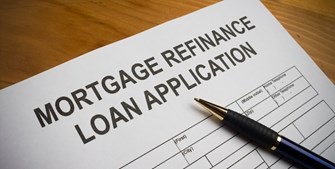Have you purchased property since 2022, when mortgage interest rates jumped from the 3% range to almost 8%? If so, you could be among millions of Americans who could benefit from refinancing the loan on your primary residence, vacation home or investment property.
Mortgage rates started dipping below 7% back in July 2024 but declined significantly after the Federal Reserve (the Fed) cut its rate by 50 basis points, or half a percent, on September 18, 2024. In fact, refinance applications jumped 20% the week following the announcement, according to the Mortgage Bankers Association (MBA).
While half a percentage point may not sound like much, refinancing around 6% could help nearly 5 million borrowers shave thousands of dollars off the principal balance of their existing mortgage, or put cash back in their pocket. This blog will briefly address what a refinance transaction entails and important considerations that property owners can use to decide if this option is right for them.
WHAT IS A REFINANCE?
A refinance transaction, or “refi” for short, involves replacing a current mortgage loan with a new one for terms that are more favorable to the borrower, in either the short or long term.
COMMON REASONS TO REFINANCE
- Lower a monthly mortgage payment
- Pay off a mortgage sooner
- Make home improvements
- Pay down debts
- Cover major expenses
COMMON TYPES OF REFINANCE TRANSACTIONS
Rate-and-Term Refi
In the long run, locking into a lower interest rate on a 30-year fixed mortgage loan can help homeowners reduce their monthly mortgage payment. For example, if you obtained a $400,000 mortgage loan at a 7.6% interest rate, refinancing with an interest rate around 6.0% could potentially lower your monthly mortgage payment from $2,824 to $2,398 – a savings of over $400 a month and $5,000 a year! A Rate-and-Term refi option also gives the borrower the flexibility to pay off the loan sooner with a shorter-term loan, such as a 15-year fixed.
Cash-out Refi
Many homeowners opt for a cash-out refinance because it allows them to leverage home equity to refinance their mortgage and receive a lump-sum amount of cash for things they want or need now. For example, many homeowners use cash-out refis to help pay for home renovations or repairs. Others use them to pay down credit card debt, or cover major expenses, like medical bills, college tuition or car payments.
ELIGIBILITY REQUIREMENTS
Although there is no official limit on the number of times you can refinance a home loan, some lenders have waiting periods and most require applicants to meet common eligibility criteria:
• Loan history: Lenders generally require a seasoning period of at least six to 12 months since the original loan closed.
• Credit score: In general, the higher your credit score, the better your chances of being approved for the loan and getting a lower interest rate. Credit score requirements vary depending on the type of loan and lender, but most lenders require a minimum credit score of 580 to qualify for refinancing and 620 to take cash out.
• Equity: Lenders prefer that borrowers have at least 20% equity in their home. It is possible to refinance with less equity, but at a higher interest rate.
• Debt-to-income (DTI) ratio: Lenders weigh your monthly financial obligations against your gross income to determine if you can afford the loan. Most lenders prefer a DTI ratio below 50%.
• Loan-to-value (LTV) ratio: Lenders divide the amount you owe on your mortgage by the appraised value of the property. In general, the lower your LTV ratio, the lower your interest rate.
• Cash reserves: Refinances often require at least two months’ worth of cash in the bank. The amount of reserves will depend on the type of property being refinanced (e.g., primary residence or investment property) and the type of loan.
• Income verification: Lenders want to know you have a stable source of income and often require proof of it from the last two years.
• Closing costs: Like all real estate transactions, refinances incur closing costs. Click here to learn more.
OTHER CONSIDERATIONS
• When is the best time to refinance?
The answer depends on your personal situation. However, if the interest rate has fallen considerably lower (generally, at least 1%) than your current home loan, you may want to explore products from various lenders to find one that fits your needs. You may also want to consider how long you’ve had your existing mortgage loan and how long you intend to own the property to determine whether the benefits of refinancing will outweigh the costs.
• Are interest rates expected to go lower?
It’s always best to do your research. Economists continually analyze economic data to predict how the Fed will adjust the federal funds rate, which in turn, drives market rates. Joel Kan, Vice President and Deputy Chief Economist for the MBA, expects the Fed will make two more interest rate cuts this year at .25% each and four more in 2025. If the stars align, we could see rates decline below 6% next year…but nobody knows for sure what the future holds.
• Are there any reduced rates available for refinance transactions?
Some lenders may offer rate reductions for enrolling in a particular program. Others might offer rate buydowns or discount points, which allow borrowers to make a one-time payment at closing that lowers their interest rate on a mortgage.
If eligible, homeowners might save on title and escrow fees from a reissued title insurance policy from the same underwriter. Some lenders and title companies in certain states may also offer rate reductions for retired and active-duty military members.
If or when you’re ready to refinance, Old Republic Title’s dedicated title and closing teams are here to protect your investment and provide a smooth closing experience. Enjoy top-notch products and services that prioritize your needs and help facilitate secure refinance transactions. To find an Old Republic Title team in your area, visit oldrepublictitle.com.




